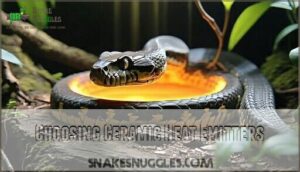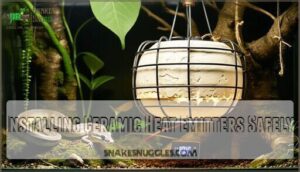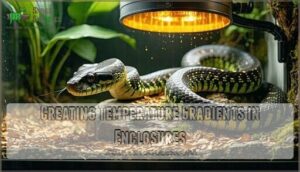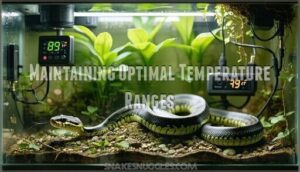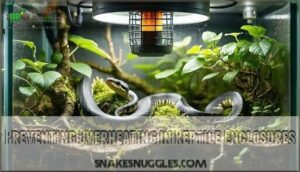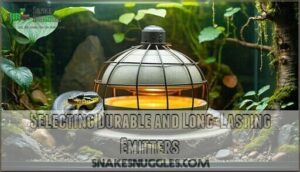This site is supported by our readers. We may earn a commission, at no cost to you, if you purchase through links.

This powerhouse delivers steady infrared heat without disruptive light, keeping your snake comfortable around the clock.
Unlike regular bulbs that mess with your boa’s sleep cycle, ceramic emitters provide pure warmth that mimics natural sunbaked rocks.
They’re energy-efficient workhorses that maintain perfect basking temperatures between 88-92°F while creating essential cool zones.
Your boa gets the temperature gradient they crave without the stress of constant brightness.
The secret lies in understanding wattage requirements, proper placement techniques, and thermostat integration for foolproof temperature control.
Table Of Contents
- Key Takeaways
- Benefits of Ceramic Heat
- Choosing Ceramic Heat Emitters
- Top 10 Ceramic Heat Emitters
- 1. LUCKY HERP Reptile Ceramic Heat Emitter
- 2. 150W Ceramic Reptile Heat Emitter
- 3. 250W Ceramic Heat Emitter for Reptiles
- 4. Fluker’s Reptile Ceramic Heat Emitter
- 5. Reptile Heat Lamp Ceramic Heat Emitter
- 6. Leoterra 150w Ceramic Heat Emitter
- 7. REPTI ZOO Ceramic Heat Emitter Bulb
- 8. Reptile Heat Lamp Ceramic Emitter
- 9. Simple Deluxe Ceramic Heat Emitter
- 10. Ceramic Heat Emitter Reptile Heat Lamp
- Placement and Maintenance
- Ceramic Heat Emitter Safety
- Frequently Asked Questions (FAQs)
- What is the best heat source for a boa constrictor?
- Are ceramic heat emitters safe for snakes?
- What is the best heat emitter for snakes?
- How many watts does a boa constrictor need?
- How long do ceramic heat emitters typically last?
- Are there specific brands recommended for boa constrictors?
- How do ceramic heat emitters impact terrarium humidity?
- Can ceramic heat emitters be used with bioactive setups?
- How often should ceramic heat emitters be replaced?
- Can ceramic heat emitters be used with timers?
- Conclusion
Key Takeaways
- You’ll want the LUCKY HERP 150W Ceramic Heat Emitter – it provides steady infrared heat without light disruption, maintaining your boa’s natural day-night cycle while creating perfect basking temperatures between 88-92°F.
- Ceramic emitters outperform traditional heat lamps because they deliver consistent 24/7 warmth that penetrates deep into your snake’s body, supporting proper digestion and thermoregulation without the energy waste of unnecessary lighting.
- Proper placement and thermostat control are non-negotiable – position your emitter 6-8 inches from basking spots to create essential temperature gradients, and always use a quality thermostat to prevent dangerous overheating that kills more boas than cold temperatures.
- Choose wattage based on your enclosure size – juvenile boas need 50-75 watts while adult enclosures (6x2x2 feet) require 100-150 watts, and quality ceramic emitters typically last 2-3 years with proper maintenance and monitoring.
Benefits of Ceramic Heat
You’ll discover that ceramic heat emitters provide consistent infrared warmth for your boa constrictor without disrupting their natural day-night cycle, since these devices produce heat without visible light.
These energy-efficient heaters create the stable thermal environment your snake needs while lasting substantially longer than traditional heat bulbs, making them a smart investment for any reptile keeper, as they are an example of energy-efficient solutions.
Infrared Heat for Boa Constrictors
Ceramic heat emitters provide infrared benefits that perfectly match your boa constrictor’s natural thermoregulation needs.
Unlike visible light bulbs, these emitters produce deep heat penetration through specific wavelength effects that warm your snake from the inside out.
This nocturnal heating solution maintains consistent boa temperature without disrupting sleep cycles, making ceramic heat emitters ideal for proper snake enclosure heat management.
Boa constrictors are active nocturnal hunters, so maintaining proper temperatures is key.
Energy Efficiency in Reptile Enclosures
Your electricity bill doesn’t have to spike when heating your boa constrictor’s enclosure.
The best ceramic heat emitter delivers consistent reptile heating while consuming less power than traditional bulbs.
Smart thermostat calibration and proper enclosure size matching maximize energy efficiency.
Unlike lighting alternatives that waste energy on unnecessary illumination, ceramic emitters focus purely on snake enclosure heat, reducing monthly costs substantially.
Safety Features for Reptile Heating
Beyond energy savings, you’ll want rock-solid safety features protecting your boa constrictor.
Quality ceramic emitters include overheat protection and thermostat reliability to prevent dangerous temperature spikes. Socket safety prevents electrical hazards, while burn prevention shields keep curious snakes from direct contact.
Material toxicity concerns disappear with properly manufactured units designed specifically for reptile enclosure heat.
- Peace of mind knowing your snake won’t get burned by exposed heating elements
- Confidence that electrical failures won’t harm your beloved boa constrictor
- Relief from worrying about toxic fumes affecting your reptile’s respiratory health
Choosing Ceramic Heat Emitters
When you’re selecting a ceramic heat emitter for your boa constrictor, you’ll need to evaluate three main factors: your enclosure’s size, your snake’s temperature requirements, and your room’s ambient temperature.
Getting these measurements right from the start will save you from buying the wrong wattage and having to start over with a different heater, which is crucial for your snake’s well-being and your own convenience, emphasizing the importance of correct temperature requirements.
Enclosure Size Considerations for Boa Constrictors
Matching your heat emitter wattage to your boa constrictor tank size guarantees proper temperature control.
Adult boas need enclosures measuring at least 6x2x2 feet, requiring 100-150 watt emitters for adequate heating. Smaller juvenile tanks work well with 50-75 watt units.
Consider vertical space and habitat complexity when calculating heating needs, as larger enclosures with climbing branches demand more power for consistent warmth distribution.
To thrive, boas also need proper humidity levels maintained consistently. For juvenile boas, a 4’x2’x2′ enclosure is generally recommended.
Desired Temperature Range for Reptiles
Temperature precision makes all the difference in boa constrictor care. Your reptile heat source should maintain 78-88°F during the day with basking spots reaching 90-95°F.
Nighttime temperatures can drop to 75-78°F safely. Regular temperature monitoring prevents health impacts from incorrect ranges.
The best heat emitter creates these ideal temperatures consistently, supporting your boa constrictor’s metabolic functions and overall wellbeing. A proper temperature gradient is essential for their health and must be maintained through a proper heat source to ensure a temperature gradient.
Ambient Room Temperature and Heating
Your room’s baseline temperature directly impacts your boa heating setup requirements.
Cold rooms demand higher-wattage emitters for consistent heat, while warmer spaces need less power.
Consider these factors when selecting the best heat emitter:
- Winter heating costs increase with colder ambient temperatures
- Summer conditions may require backup heating during air conditioning use
- Seasonal adjustments help maintain ideal temperature year-round
Monitor your reptile heat source performance regularly to ensure it is working correctly, and make seasonal adjustments as needed to maintain the optimal environment.
Top 10 Ceramic Heat Emitters
You’ll find the most reliable ceramic heat emitters for your boa constrictor’s habitat in this carefully selected list, which includes options ranging from budget-friendly models to premium units with advanced safety features.
Each emitter has been tested for durability, heat output consistency, and compatibility with standard reptile enclosures, so you can choose the right one based on your snake’s specific temperature needs and your enclosure size.
1. LUCKY HERP Reptile Ceramic Heat Emitter
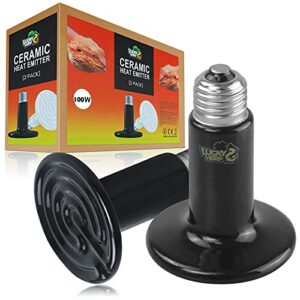
The LUCKY HERP Ceramic Heat Emitter stands out with its versatile wattage options ranging from 50W to 250W.
Looking for flexible heating power? The LUCKY HERP delivers with wattage options from 50W to 250W for any enclosure size.
You’ll appreciate how it delivers consistent infrared heat without producing visible light, keeping your boa’s natural day-night cycle intact.
This ceramic emitter penetrates deep into your snake’s body, supporting essential metabolic functions that glass heat lamps simply can’t match.
Its durable ceramic construction resists high temperatures while offering superior energy conservation.
You can trust this reliable heating solution to maintain ideal thermal gradients in your terrarium.
Best For: Reptile owners seeking reliable, light-free infrared heat to maintain natural cycles and proper temperatures in terrariums.
- Surface becomes extremely hot and requires careful installation.
- Some users report early unit failures or rapid temperature drops.
- More expensive than basic glass heat lamps.
- Multiple wattage options for different enclosure sizes and species.
- Durable ceramic build with consistent heat output and energy efficiency.
- No visible light emission, keeping nocturnal reptiles’ routines undisturbed.
2. 150W Ceramic Reptile Heat Emitter
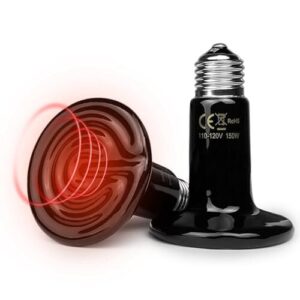
With 3" x 3" x 4.3" dimensions, this DOMICA 150W ceramic heat emitter delivers natural sun-like infrared warmth that’ll keep your boa comfortable around the clock.
You’ll appreciate how it maintains healthy sleep cycles without disrupting normal photo periods—no bright lights disturbing your snake’s rest.
The E26 base fits standard 110-120 volt fixtures, making installation straightforward.
Users report their reptiles appear cozier and quieter, indicating real comfort improvements.
At a fraction of PetSmart’s prices, this durable ceramic construction offers comparable performance while lasting over three months of continuous operation.
Best For: Reptile owners—especially those with boa constrictors or similar species—who want a safe, effective, and affordable heat source that won’t disturb animals’ sleep cycles.
- Surface gets extremely hot and must be kept away from flammable materials.
- Requires a compatible lamp fixture rated for 150W, or it can overheat.
- Does not include a thermostat or lamp fixture, which are necessary for safe use.
- Provides natural sun-like infrared heat without any visible light, ideal for proper reptile rest and health.
- Durable ceramic construction with a standard E26 base fits most enclosures and lasts for months of continuous use.
- Offers excellent value, performing as well as pricier brands like PetSmart at a much lower cost.
3. 250W Ceramic Heat Emitter for Reptiles
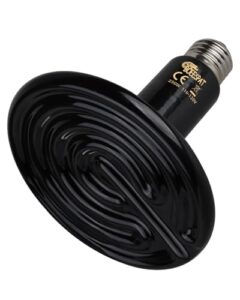
When your boa constrictor needs serious heat, this 250-watt powerhouse delivers the thermal punch you’re looking for.
You’ll appreciate its infrared technology that penetrates deep into your snake’s scales, promoting healthy blood circulation without disrupting sleep cycles.
The ceramic construction guarantees durability while providing consistent, long-wave heat distribution throughout larger enclosures.
With its impressive 15,000-hour lifespan and 99% thermal efficiency, you’re investing in reliable performance.
Just remember to use a protective bulb cage – this emitter gets hot enough to cause burns on contact, ensuring the need for reliable performance and protective measures.
Best For: Boa constrictor owners and reptile keepers needing steady, powerful heat for large enclosures without disturbing their animals’ natural cycles.
- Can cause burns on contact; requires a protective bulb cage
- Some users report inconsistent temperature performance in chick brooders
- Occasional issues with bulbs arriving broken
- Penetrating infrared heat promotes reptile health and blood circulation
- No visible light lets reptiles stay on natural day/night schedules
- Durable, energy-efficient ceramic construction with long lifespan
4. Fluker’s Reptile Ceramic Heat Emitter
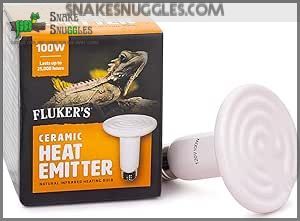
Everyone needs reliable heating that won’t break the bank, and Fluker’s delivers exactly that.
This 100-watt ceramic heat emitter works perfectly with their clamp-lamps, making installation a breeze.
You’ll appreciate how it provides consistent infrared heat without any disruptive light, keeping your boa comfortable around the clock.
The UL rating gives you peace of mind about safety, while the energy-efficient design saves money on electricity bills.
It’s particularly effective for larger enclosures where you need dependable warmth that penetrates deep into your snake’s body, providing a comfortable environment with consistent infrared heat.
Best For: Reptile owners needing reliable, 24-hour heat for larger enclosures, especially those housing nocturnal or sensitive species like boa constrictors.
- Surface gets extremely hot and requires careful handling
- Needs accurate temperature monitoring to prevent overheating
- Not suitable for use directly on glass or plexiglass surfaces
- Provides intense, consistent infrared heat without emitting light
- Energy-efficient and long-lasting, supporting year-round use
- Easy installation with most clamp lamps and safe with UL rating
5. Reptile Heat Lamp Ceramic Heat Emitter
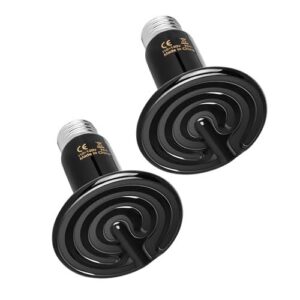
Dependability matters when you’re heating your boa’s habitat around the clock.
This ceramic heat emitter delivers steady 75W performance through a standard E26 base that fits most reptile fixtures.
You’ll appreciate its high-purity ceramic construction with Ni-Cr alloy resistance wire that resists cracking and moisture damage.
The unit heats up quickly and maintains consistent temperatures without producing light that’ll disturb your snake’s sleep cycle.
At 75mm diameter, it’s compact enough for smaller enclosures while providing reliable thermal output for months of continuous operation.
Best For: Reptile owners, especially those with boa constrictors, seeking reliable, light-free warmth for smaller enclosures.
- Surface gets extremely hot and requires caution to avoid burns or overheating nearby materials.
- Requires additional regulation equipment for optimal safety and temperature control.
- May cause some drying of air in enclosed spaces, especially in grow tents.
- Provides stable, non-light heat ideal for maintaining reptile sleep cycles.
- Durable construction resists moisture and cracking, supporting months of continuous use.
- Fits standard E26 sockets and heats up quickly for fast temperature control.
6. Leoterra 150w Ceramic Heat Emitter
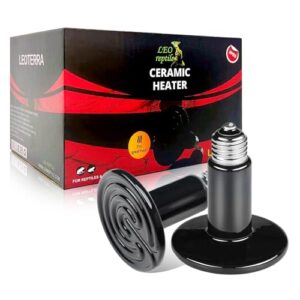
For medium-sized boa enclosures, this 150-watt ceramic heat emitter delivers steady infrared warmth without disrupting your snake’s natural light cycle.
You’ll appreciate its 10,000-hour lifespan, which means fewer replacements and consistent heating performance.
The ceramic construction distributes heat evenly across your boa’s habitat, maintaining those vital nighttime temperatures between 80-85°F, and it’s compatible with standard fixtures and works seamlessly with digital thermostats.
While it runs hot, proper placement guarantees your boa gets the penetrating heat needed for healthy digestion and thermoregulation.
Best For: Medium to large reptile owners, especially those with boa constrictors, who need reliable, long-term nighttime heat without disturbing natural light cycles.
- Surface gets very hot, requiring careful placement to prevent burns
- Not recommended near flammable materials or for poorly ventilated setups
- Some reports of early failure when misused or used in unsuitable environments
- Delivers consistent infrared warmth for proper reptile thermoregulation
- Long 10,000-hour lifespan means fewer replacements and lower maintenance
- No visible light emission, so it won’t disrupt your snake’s day/night pattern
7. REPTI ZOO Ceramic Heat Emitter Bulb
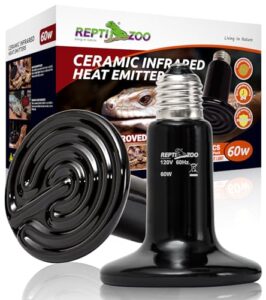
The REPTI ZOO Ceramic Heat Emitter Bulb delivers consistent infrared heating without disrupting your boa’s natural sleep cycle.
You’ll appreciate its specialized ceramic construction that prevents temperature fluctuations while maintaining ideal 85-95°F ranges.
This emitter’s 10,000-15,000 hour lifespan means fewer replacements, and it works seamlessly with digital thermostats for precise control.
Available in 50W, 100W, and 150W options, you can match the wattage to your enclosure size.
Its moisture-resistant design handles high-humidity environments perfectly, making it ideal for creating proper temperature gradients.
Best For: Boa constrictor and reptile owners seeking stable, non-disruptive infrared heat for glass terrariums and high-humidity enclosures.
- Must be paired with a ceramic socket fixture (not all lamps are compatible).
- Higher upfront cost than traditional heat bulbs.
- Limited to heating smaller or mid-sized enclosures (20–40 gallon recommended).
- Long lifespan (10,000–15,000 hours) means fewer bulb replacements.
- No visible light emission, so it doesn’t disrupt sleep or natural cycles.
- Works well with digital thermostats for precise temperature control.
8. Reptile Heat Lamp Ceramic Emitter
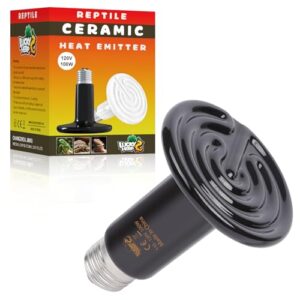
When consistency matters most, this reptile heat lamp ceramic emitter delivers reliable performance for your boa’s habitat.
You’ll appreciate its durable ceramic construction that withstands high temperatures while providing steady infrared heat.
The unit heats up quickly within minutes, reaching ideal temperatures without producing disruptive light.
It’s compatible with standard E26 lamp holders, making installation straightforward.
Users report excellent longevity, often lasting years with proper care.
The even heat distribution creates comfortable basking zones, though you’ll want to pair it with a quality thermostat for precise temperature control.
Best For: Boa constrictor owners and reptile enthusiasts who need consistent, light-free heat for their animal’s habitat.
- May struggle to reach higher temperatures in larger enclosures
- Requires a ceramic socket and thermostat for safe, effective operation
- Some reports of bulbs burning out prematurely during heavy winter use
- Heats quickly and maintains stable temperatures without emitting light
- Durable ceramic construction with a long lifespan
- Easily integrates with standard E26 lamp holders for hassle-free setup
9. Simple Deluxe Ceramic Heat Emitter
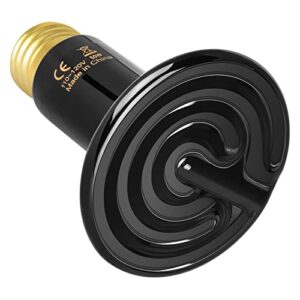
The Simple Deluxe Ceramic Heat Emitter stands as a reliable workhorse for your boa constrictor’s heating needs.
You’ll appreciate its durable ceramic construction that delivers consistent infrared warmth without disrupting your snake’s natural sleep cycle.
This UL-listed unit operates efficiently at standard voltage while creating the perfect temperature gradient your boa requires.
Compatible with most ceramic socket fixtures, it’s designed for both horizontal and vertical mounting, and with proper installation and thermostat control, you can expect 3-5 years of dependable heating performance.
Best For: Reptile owners who need consistent, long-term heat without light disruption, especially for boa constrictors and other heat-loving species.
- Heat stays close to the bulb, limiting coverage area.
- Surface becomes very hot; requires caution during handling.
- Some users report a burning smell during initial use.
- Durable ceramic design with even, infrared heat and no visible light.
- Maintains ideal basking temperatures and stable thermal gradients.
- Compatible with most ceramic sockets and suitable for multiple mounting options.
10. Ceramic Heat Emitter Reptile Heat Lamp
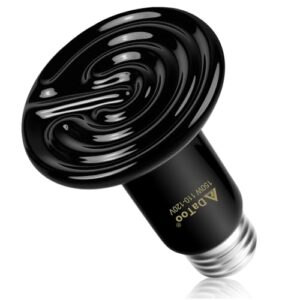
When you’re looking for a reliable heating solution that won’t break the bank, this ceramic heat emitter delivers solid performance for your boa’s habitat.
You’ll appreciate its standard E26 base that fits most lamp fixtures, making installation straightforward.
The ceramic construction provides steady infrared heat without light output, so your snake’s day-night cycle stays undisturbed.
While it may not have premium features like some high-end models, it gets the job done effectively, and is a practical choice that keeps your boa comfortable without emptying your wallet.
Best For: Boa constrictor owners seeking an affordable, reliable, and light-free heat source for their reptile enclosures.
- May produce a faint rattling sound inside the bulb
- Some models lack advanced features like built-in temperature regulation
- Requires a quality ceramic socket and safe mounting to prevent hazards
- Provides consistent infrared heat without disturbing snakes’ day-night cycle
- Fits standard E26 lamp fixtures for easy installation
- Energy efficient and suitable for 24-hour use
Placement and Maintenance
You’ll need to position your ceramic heat emitter at one end of the enclosure to create a proper temperature gradient, keeping it at least six to eight inches away from your boa’s basking spots.
Regular cleaning and monthly checks of your thermostat settings will guarantee your snake stays comfortable and your equipment lasts longer.
Installing Ceramic Heat Emitters Safely
Proper installation keeps your boa constrictor heat setup running smoothly.
Mount your ceramic heat emitter in a quality ceramic socket – never plastic ones that’ll melt.
Install protective guards around the fixture to prevent burns.
Follow distance guidelines by keeping the emitter 6-8 inches from your snake’s basking spot.
Consider complete heat solutions for ideal temperature control.
Always calibrate your thermostat before connecting any reptile habitat heating equipment for maximum safety.
Creating Temperature Gradients in Enclosures
Placing your ceramic heat emitter strategically creates essential thermal zones for your boa constrictor’s well-being.
Position the heat source at one end, establishing a hot spot around 88-90°F while maintaining cool zone access at 75-80°F on the opposite side.
This temperature gradient allows natural thermal regulation, letting your snake choose ideal body temperatures for digestion and comfort throughout their reptile enclosure.
Maintaining Optimal Temperature Ranges
Your ceramic heat emitters need consistent monitoring to maintain ideal temperatures for boa constrictors.
Set your thermostat calibration between 88-92°F on the warm side and 78-80°F on the cool side.
Temperature monitoring becomes especially important during seasonal adjustments when room temperatures fluctuate.
Proper ranges improve immune function and wellbeing and are crucial for your snake’s thermal regulation.
Check gradient importance daily – your snake’s perfect health depends on these precise reptile heating requirements.
Ceramic Heat Emitter Safety
You’ll want to prioritize safety when using ceramic heat emitters, as these powerful devices can reach extremely high temperatures that pose burn risks to both you and your boa constrictor.
Proper installation with thermostats, protective guards, and careful placement guarantees your snake stays warm without creating dangerous hot spots or fire hazards in the enclosure, which is crucial for maintaining a safe environment with ceramic heat emitters.
Preventing Overheating in Reptile Enclosures
Overheating kills more boa constrictors than cold temperatures ever will.
Heat kills faster than cold—your boa’s life depends on proper temperature control.
Monitor your ceramic heater’s wattage carefully—too much power in small spaces creates dangerous hot spots.
Proper enclosure ventilation prevents heat buildup, while maintaining safe distance guidelines keeps your snake from burns.
Choose ceramic heaters with built-in safety features and always use heat-resistant materials in your reptile enclosure setup.
Using Thermostats for Temperature Control
Smart thermostats transform your ceramic heater into a precision instrument for your boa heating setup.
These devices provide automated regulation and temperature consistency that manual monitoring can’t match.
Quality controllers offer thermostat calibration, night drops, and emergency shutoff features.
Consider using a ceramic heat regulator for ideal safety.
Without proper temperature control, even the safest heat emitter becomes a liability in reptile heating systems.
Selecting Durable and Long-Lasting Emitters
Beyond temperature regulation, you’ll want ceramic emitters built to last. Think of it like buying a reliable car – upfront investment pays dividends over time.
Here’s what separates quality from junk:
- Material composition – Premium aluminum oxide ceramic withstands repeated heating cycles better than cheap alternatives
- Lifespan expectations – Top brands offer 5,000+ operational hours with solid warranty details
- Brand reputation – Established manufacturers provide protective coatings and proven reptile heating solutions
To guarantee proper heating, consider enclosure size’s impact on wattage.
Frequently Asked Questions (FAQs)
What is the best heat source for a boa constrictor?
While traditional heat lamps seem obvious, you’ll find ceramic heat emitters work best for boa constrictors.
They provide consistent 24/7 infrared warmth without disrupting your snake’s natural day-night cycle or sleep patterns, which is crucial for maintaining their health and natural behavior.
Are ceramic heat emitters safe for snakes?
Yes, ceramic heat emitters are safe for snakes when used properly.
They provide consistent warmth without light disruption, but you’ll need a thermostat to prevent overheating and maintain proper distance from your snake.
What is the best heat emitter for snakes?
In terms of keeping your slithery friend cozy, ceramic heat emitters are the gold standard.
They provide consistent warmth without light disruption, making them perfect for maintaining your snake’s natural sleep cycle.
How many watts does a boa constrictor need?
You’ll need a 100-150 watt ceramic heat emitter for most adult boa constrictors, depending on your enclosure size and room temperature.
Larger tanks require higher wattage to maintain proper basking temperatures.
How long do ceramic heat emitters typically last?
Picture your ceramic heat emitter glowing steadily through countless nights.
You’ll typically get 2-3 years of reliable service from quality units, though some last up to 5 years with proper care and thermostat control.
Are there specific brands recommended for boa constrictors?
Zoo Med and Repticare stand out as top-rated manufacturers you’ll want to keep in mind.
Both brands offer reliable, durable ceramic heat emitters specifically designed for reptile habitats, ensuring your boa gets consistent warmth.
How do ceramic heat emitters impact terrarium humidity?
Like a gentle fan in summer, ceramic heat emitters reduce humidity by creating air circulation and evaporation.
You’ll notice drier conditions, so monitor levels closely and add water dishes or misting to maintain your boa’s ideal 60-70% humidity range, ensuring the environment remains suitable for your pet by also considering the use of misting.
Can ceramic heat emitters be used with bioactive setups?
You can absolutely use ceramic heat emitters with bioactive setups.
They won’t harm beneficial bacteria or plants since they produce gentle, consistent heat without harsh light that could disrupt your terrarium’s natural ecosystem, allowing for a healthy environment with gentle heat.
How often should ceramic heat emitters be replaced?
Time flies when you’re keeping your snake cozy.
Ceramic heat emitters typically last 9,000-15,000 hours.
You’ll need to replace yours every 1-2 years with regular use, depending on quality and usage patterns.
Can ceramic heat emitters be used with timers?
You shouldn’t use timers with ceramic heat emitters for boa constrictors.
These reptiles need constant, steady heat around the clock.
Turning heat on and off disrupts their thermoregulation and can stress your snake substantially.
Conclusion
Theory suggests that reptiles need complex heating systems, but ceramic emitters prove simplicity wins.
You’ve discovered the best ceramic heat emitter for boa constrictors creates perfect basking spots without overwhelming your setup.
Whether you choose the LUCKY HERP 150W or another top-rated option, consistent infrared warmth keeps your snake healthy year-round.
Remember to pair your emitter with a reliable thermostat and monitor temperatures regularly.
Your boa will thrive with proper ceramic heating that mimics their natural environment perfectly.
- https://en.wikipedia.org/wiki/Dummy_pronoun
- https://www.reptileknowledge.com/news/the-perfect-boa-constrictor-habitat/
- https://snakesinfo.com/boa-constrictor-enclosure/
- https://alinereptiles.com/boa-constrictor-enclosure/
- https://lion-gopher-smj3.squarespace.com/s/FBH-Recommended-Minimum-Enclosure-Size.pdf

